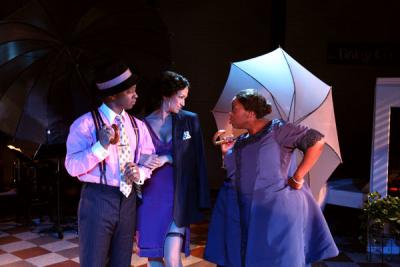White Is Riveting in ‘Big Maybelle’

Like the blues itself, “Big Maybelle: Soul of the Blues,” through Sept. 2 at the Bay Street Theatre in Sag Harbor, is a terrible beauty. Born out of the horror of slavery and the ongoing march to overcome its far-reaching legacy, blues music gives voice to the dichotomies of uplift and anguish, hope and despair.
“Big Maybelle” draws a tragic portrait of a life mortally wounded by abandonment, depression, and drugs. Through the pain of a broken home, a self-loathing blamed in part on her lifelong obesity, the resulting affliction with diabetes, and a heartbreaking attraction to men who would desert her as her father did, Mabel Louise Smith, a k a Big Maybelle, nonetheless climbed the show-business ladder of midcentury America. From singing in church in her hometown of Jackson, Tenn., Smith rose to the chitlin’ circuit and multiple record labels, finally playing to the ultimate arbiters of quality and class at the Newport Jazz Festival and Carnegie Hall.
Smith never attained the stature of her contemporaries — Etta James, Dinah Washington, Billie Holiday, and Ella Fitzgerald — but did record a string of hits for the Okeh and Savoy labels, among them “Whole Lotta Shakin’ Goin’ On” (in 1955, two years before Jerry Lee Lewis would record it) and, the following year, “Candy.”
Smith was born into a hardship typical of African-Americans in the post-Civil War South. At 3, her father abandoned the family, an event that would have profound implications throughout her life. Equally pivotal, however, was the blue ribbon the singer brought home at age 8 from an amateur contest. The girl’s evident bliss in the act of singing did not escape her mother’s notice, and Smith was destined for an artist’s life.
In a diabetic coma, Smith died at age 47 in a Cleveland hospital in 1972. It is from her austere hospital room, often in bed, that her life is recalled in “Big Maybelle.”
In song and spoken word, the Tony Award-winner Lillias White channels Big Maybelle, deftly baring the vulnerability lurking beneath the sassy exuberance and raw power exuded by the larger-than-life R&B chanteuse, as her art takes her from Jackson to Memphis to Cincinnati to New York and beyond.
As Smith, Ms. White is a one-woman tornado, commanding attention from the farthest reaches of the theater, losing herself in the gritty, up-tempo R&B, frequently holding the last note of a line with a powerful and husky vibrato, and tossing impish and often suggestive asides to the band and audience. Though a first-rate, six-piece band is onstage throughout, Ms. White is almost a one-woman show.
Yet the band is very much a part of the show: The drummer Eric Brown steps out and into the action as Smith’s recurring love interest, Sully, the man who fatefully introduced her to heroin and repeatedly left her, a casual cruelty to which Ms. White refers time and again.
Kiku Collins, on trumpet, doubles as Loretta, a woman for whom Sully has left Smith. In the svelte Loretta, the point is made: The unsavory Sully has lost interest in the full-figured Maybelle. Smith is crushed and, illustrating her sorrow in songs including “The Masquerade Is Over” and James Brown’s “It’s a Man’s Man’s Man’s World,” turns to drugs and liquor, very much alone in her Harlem apartment.
Unseen but oft-mentioned is the record producer Fred Mendelsohn, president of Savoy Records and guiding hand of Smith’s career. (Mendelsohn is credited as the first man to record and promote African-American gospel music.)
The bandleader and pianist Michael Mitchell delivers a standout performance, weaving long melodic runs around Ms. White’s powerhouse vocals and darting in and out of same with short, sharp licks. The band, also made up of George Farmer (bass), Jason Marshall (saxophone), and John Putnam (guitar), dexterously supports but never oversteps the vocalist — not that such a feat would be easy or even possible. Ms. White, who has received Tony Awards and nominations for roles including Sonia (“The Life”) and Funmilayo (“FELA!”) and has multiple television, film, and theater credits, is always in control.
She displays the same mastery in revealing Smith’s recurring demons: Blaming herself for her father’s disappearance, she engages in the self-reinforcing and self-destructive behavior of overindulgence in food, drugs, and, agonizingly, Sully.
The presentation is sometimes augmented with video projected above and behind the players: the rural South, African-American church congregations, the hustle of New York City nightlife. Likewise, neon
